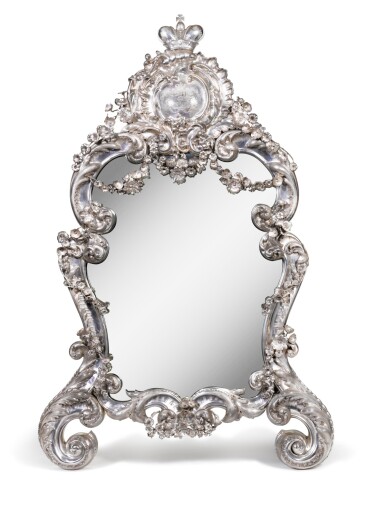Russian Works of Art
Russian Works of Art

Property from a Washington D.C. Private Collection
A LARGE AND RARE ROCOCO SILVER MIRROR, JEAN-BAPTISTE VAILLANT, ST PETERSBURG, 1846
Lot Closed
June 17, 03:32 PM GMT
Estimate
20,000 - 30,000 GBP
Lot Details
Description
Property from a Washington D.C. Private Collection
A LARGE AND RARE ROCOCO SILVER MIRROR, JEAN-BAPTISTE VAILLANT, ST PETERSBURG, 1846
of elongated cartouche form, decorated with scrolls, shellwork and flowers, the top engraved with the Yusupov coat-of arms and surmounted by a crown, with suspension wire on reverse, struck with maker’s initials, 84 standard
height 121.7cm, 47⅞in.
Please note: Condition 11 of the Conditions of Business for Buyers (Online Only) is not applicable to this lot.
To view Shipping Calculator, please click here
The Collection of Princess Zinaida Nicolaevna Yusupov and her husband, Count Felix Sumakarov-Elston
Acquired by Edward C. Finch in Russia (then the Russian Soviet Federative Socialist Republic) on the 5th of September 1927 for 1000 roubles, as part of the 'toilet set of Count Yusupov'
Thence by descent
This rare and historic collection of silver from the private collection of Prince Felix Yusupov and his wife, Princess Irina Alexandrovna appears on the market for the first time since it was acquired by Edward C. Finch in Russia in 1927. The present mirror, along with the candelabra (lot 147), table bell and toilet box (lot 148) all originally formed part of the toilet set of Count Yusupov.
Princess Zinaida Nicolaevna Yusupov and Count Felix Sumakarov-Elston
An aristocrat and husband to Emperor Nicholas II’s niece, Prince Felix is perhaps best known for his participation in the assassination of Rasputin. Richer even than the Romanovs, the Yusupov family amassed their fortune over many generations. Their fortune included four palaces in Saint Petersburg, three palaces in Moscow, thirty-seven estates throughout Russia, coal and iron-ore mines, plants and factories, mills and oil fields on the Caspian Sea. Forced into exile following the Emperor’s abdication, Felix and Irina fled Russia with very few of their possessions.
Hidden Treasure
Before fleeing in autumn 1917, Prince Felix Yusupov sought to conceal a portion of his family's treasures from the Revolutionaries. Jewellery and art objects, including the Yusupov Scandinavian service (lot 149), were walled up under a staircase of the Yusupov's Moscow house, a former hunting lodge of Ivan the Terrible (see Prince Felix Yusupov, Lost Splendor, New York, 2014, p. 277). The Bolsheviks occupied most of the Yusupov’s properties, including the mansion in central Moscow. It was not until 1925 during repairs to the building that a secret storage, containing jewellery, gold and silver, was found under the staircase.
The Soviet government held a very pragmatic view of Imperial treasures, selling them abroad or even melting them down. Thankfully, some of this group was salvaged in September 1927, when a wealthy American traveller Edward C. Finch bought it from a Soviet shop to benefit Russian children. It was during his travels in Russia that Edwards C. Finch also collected the present group of porcelain from the Farm Palace Banquet Service (lots 151-157).
This group of treasures travelled to the United States, where it remained in Edward C. Finch’s private family collection, from which it is now presented.
Edward C. Finch
Edward Corwin Finch (1862 – 1933) was an American businessman, real estate developer and philanthropist in the state of Washington. He served in the Washington State Senate from 1927 to 1931 and travelled to Russia while on honeymoon with his second wife.
Vaillant
Known for works of exceptional weight and quality, Jean-Baptiste Vaillant arrived in St Petersburg around 1842 and quickly established himself as one of the city’s leading silversmiths. In 1847 Vaillant won the Imperial prize for the annual Peterhof Regatta and, by 1848, he was supplying the Imperial Court. Vaillant’s fame grew and he was awarded first prize at the St Petersburg Industrial Art Exhibition in 1849 for ‘works of gold and works of diamonds and pearls framed in gold’. A. Borov, one of the judges on the Industrial Art Exhibition panel, described Vaillant: ‘The works of Sazikov and Vaillant may be described as refined in the fullest sense of the word, and some of their creations even move beyond the bounds of ordinary crafts, and stand [to] compare with true works of art.’ In addition to jewelled works, Vaillant was particularly known for accomplished the three dimensionality of his works in silver (L. Zavadskaya, ‘Gold and Silver in St Petersburg, 1830-1850’, G. von Habsburg, exhibition catalogue, Fabergé: Imperial Craftsman and His World, London, 2000, p. 49 and p. 51).
